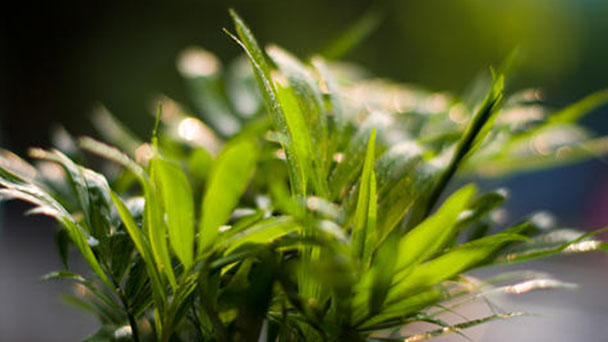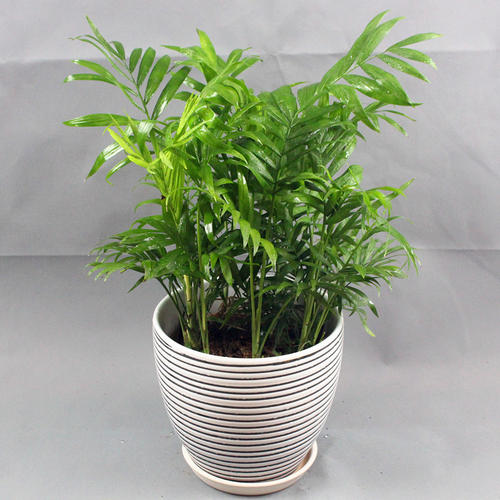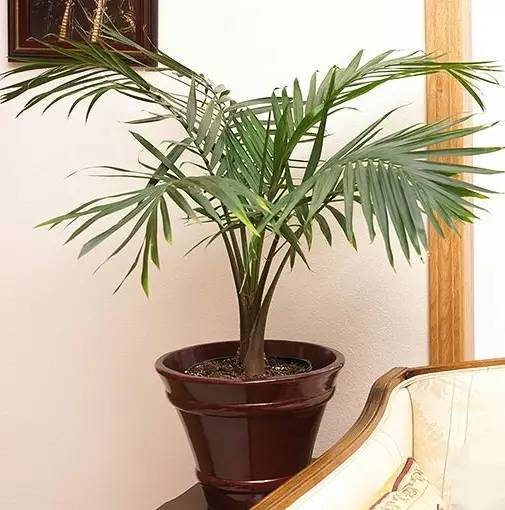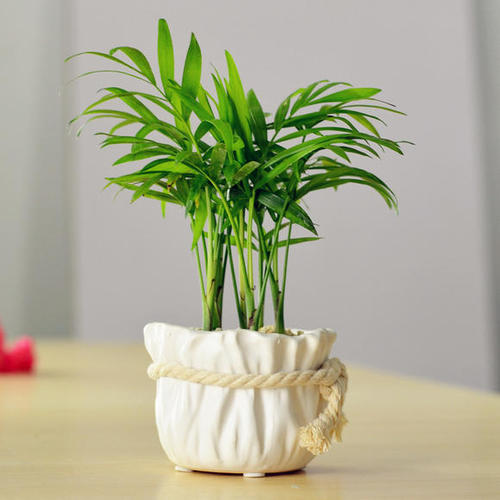Parlour palm profile
Written by Maggie
Jan 28 2021

Parlor palm, scientific name Chamaedorea elegans, belongs to the Palm family, native to Mexico and Guatemala. With its resistance to shade, it is very suitable for indoor small and medium-sized potted plants, decorative living room, study, conference room, hotel desk and another indoor environment, can make the indoor atmosphere and flavor of tropical scenery added. Place Parlor palm in the corner of the room or on the tea table can be added to the room full of business atmosphere so that the indoor charming tropical scenery.
Parlor palm picture

Parlor palm morphological characteristics
Parlor palm (Chamaedorea elegans) is not more than 1 m in height in potted plants. The stems are slender and erect, unbranched, dark green, with irregular rings. Leaves are produced from the top of the stem, pinnate compound leaves, fully divided, lobes broadly lanceolate, pinnate leaflets 20~40, falcate, dark green, glossy. The Parlor palm is spring flowering, spicate flesh axillary, dioecious, male flowers slightly erect, female inflorescences slightly drooping when the nutrition condition is good, flowers yellow beadlike; Small berries are orange-red or yellow.
Parlor palm (Chamaedorea elegans) height is 4-5m, long and thin. Leaf apex, pinnate compound leaf arch, sharptail, apex 2 cracks. Fleshy spike inflorescence pendulous, concerns, flowers unisexual, monoecious.
Parlor palm (Chamaedorea elegans) grows at the optimum temperature of 20-30℃, enters dormancy state at 13℃, and overwintering temperature is 10℃.
Parlor palm is a small perennial evergreen shrub in the palm family, Mexican palm, with erect, solitary, dark green stems with irregular stripes. Leaves are pinnately divided, lobes lanceolate, dark green, glossy. Parlor palm has about 120 species of the same genus, mainly distributed in the Central American tropical areas. parlour palm likes high-temperature high humidity and half shade environment. It is in plant taxonomy for palm evergreen low shrub or small tree, plant short. Investigate its English kind name is beautiful meaning. It is called Parlour palm because of its small and exquisite and beautiful shape, which is like tropical coconut palm.
Ecological Habits of Parlor palm
Parlor palm (Chamaedorea elegans) loves a warm, moist and semi-cloudy environment. The suitable temperature for growth is 20~30 degrees, 13 degrees into the dormant period, the lowest winter overwintering temperature is 3 degrees. Parlour palm is the best cultivation substrate with good drainage, wet, fertile loam, leaf rot soil peat soil with 1/4 river sand and a small amount of basal fertilizer for potting. Parlor palm is not high to fertilizer requirement, general growth season every month 1-2 times liquid fertilizer, autumn end and winter slightly fertilization or not fertilization. Repot every 2-3 years in the spring.
Parlor palm main value
The role that occupies the home
Parlor palm (Chamaedorea elegans) can purify benzene, trichloroethylene and formaldehyde in the air at the same time, and is the "high-efficiency air purifier" in plants. Parlour palm is very suitable for display in the indoor or newly decorated bedroom.
Application value
Parlor palm (Chamaedorea elegans) is a small and exquisite plant with graceful shape, graceful posture, dark green and bright leaf color, strong negative resistance. Parlour palm is an excellent indoor medium and small potted leaf plant. Parlour palm has flat leaves, mature plants such as umbrella-shaped, dignified dignified dignified, simple and meaningful, natural leaves, jade embellish crystal, give a person with sincere simple, full of vitality. Small plant appropriate is planted with small basin, buy a desktop, it is a treasure on the stage, also the appropriate suspension is indoor, decorate a space. Parlour palm can be displayed in the hall, meeting room and airport waiting room. It is an important foliage plant for beautifying the room and has become popular all over the world.
Parlour palm distribution range
Parlor palm (Chamaedorea elegans) is native to northern Mexico, Guatemala, southern China and Taiwan are cultivated.

Parlour palm propagation methods
Parlor palm (Chamaedorea elegans) can be propagated by sowing and dividing plants.
Seeding method
After flowering in April to May, Parlor palm (Chamaedorea elegans) can bear fruit by artificial pollination, and the fruit takes half a year to mature. Seedbed made with wooden cases, moderate specifications can be. The matrix of Parlour palm was mixed with 3 parts of leaf rot soil, 2 parts of mountain soil, 2 parts of humus soil and 3 parts of sandy soil, which were fully insolated and finely screened for reserve. Before sowing, the seeds were soaked in warm water at 35 ~ 40℃ for 36 hours. When the seeds of Parlor palm were fully absorbable, expanded and shiny, the seeds were planted on demand. The soil was covered with 1.5cm, and the water was sprayed with a fine hole watering can. After sowing, the soil should be kept moist, the temperature of the seedbed should be controlled between 22 and 25℃, and the seeds should germinate after 30 to 40 days. When the seedlings of Parlor palm grow 2 ~ 3 pieces of true leaves, they can take the dumplings on the pot. The basin soil is dominated by loose, well-drained and fertile humus soil. Potassium, nitrogen and phosphorus are placed at the bottom of the basin, of which 60% is potassium, 15% is nitrogen, and 25% is phosphorus. In addition, an appropriate amount of decaying chicken and duck feathers and barnyard manure is placed, and a small amount of carbofuran and dry tobacco dust is sprinkled to prevent insect pests.
Division propagation
Parlor palm (Chamaedorea elegans) tillers more at the seedling stage, should reach the plant at a time. More in the late winter and early spring before the plant to restore growth. The mixed substrate of peat and perlite was selected, and the plastic flowerpot with a diameter of 15 cm to 20 cm was used, and the clay sand was added to the bottom of the pot as the drainage layer. Parlour palm, soilless potted plants of more than one year old, planted in the above mixed matrix in the spring, with 3 to 4 plants per potted.
Parlor palm growing methods
Lighting: Parlor palm (Chamaedorea elegans) likes shade, leaves yellow in strong sunlight; If left in poor light for a long time, the plant will become lean and elongated. So it had better be in an indoor window edge bright place.
Temperature: Parlor palm (Chamaedorea elegans) likes warm, grows in optimum temperature of 18 -- 24 ℃, 13 ℃ into dormancy. It's better not to be below 10 degrees Celsius in winter.
Water: Parlour palm loves water, keep the soil moist while it is growing, and water it in dormant until two-thirds of the pot is dry. Also, Parlor palm likes high air humidity, if it is too dry, the tip of the leaves will turn brown. Therefore, during the dry period such as autumn, it is necessary to take measures such as frequent spraying of water on the leaf surface to improve the air humidity around the plant.
Fertilization: Compound fertilizer can be applied to the Parlor palm once a month during the growing season.
Basin soil: with drainage good, loose and fertile soil is planted best.

Latest Updated
- Benefits of Bugleweed - 7 Science-backed Health Benefits
- Bugleweed Dangers & Side Effects - Is It Poisonous?
- How to Plant Evergreen Trees - What You Should Know
- When to Plant Evergreens - Grow Guide for Evergreen Trees
- 12 Wonderful Evergreen Shrubs for Your Garden
- 12 Popular Evergreen Plants with Pictures for Beginners
- When And How To Prune A Lilac Bush Like a Pro
- How to Grow & Care for Lilac Vine (Hardenbergia Violacea)
- Japanese Lilac Tree (Syringa Reticulata) Care & Propagation Guide
- Shumard Oak Pros and Cons - What to Know
Popular Articles
- Winter maintenance of Antirrhinum Majus
- How to Grow Terminalia Mantaly Tree
- How to Grow and Care for Crossostephium Chinense
- How to grow Antirrhinum Majus in spring
- Peristeria Elata (Dove Orchid) Profile: Info & Care Guide
- Underwatered Snake Plant (Sansevieria Trifasciata) - Signs And How To Fix
- How to Care for Brazilian Jasmine Plant (Mandevilla Sanderi)
- How to Grow & Care for Graptopetalum Purple Delight in Summer
- Rosa Chinensis (China Rose): Plant Growing & Care Tips
- How to Care for Baby Sun Rose (Aptenia Cordifolia)